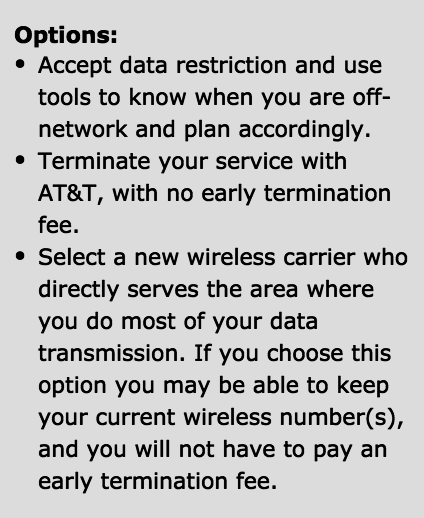In the past few weeks we have been receiving reports from members that AT&T has sent out a round of domestic roaming cap enforcement notifications.
The reports are coming in from customers of all types of AT&T lines - smartphones, hotspots, Connected Car devices and wireless home internet devices.
These have come in the form of emails to affected customers. The notifications indicate that lines that have surpassed domestic roaming limits will no longer have access to domestic roaming data.


Domestic Roaming (aka, off-network usage) is when a cellular carrier has agreements with other US-based networks to utilize their towers, helping the carrier provide connectivity to customers who are just passing through areas the carrier doesn’t directly service.
Though customers are rarely charged directly for roaming anymore, behind the scenes roaming costs your carrier a substantial amount.
A carrier may have different limits on their plans for domestic roaming (ie. within the US), North America (Canada/Mexico) and international.
AT&T told our staff that while they haven't been reliably enforcing their domestic roaming caps in recent past, they are starting to do so. Customers who have called in to inquire are told that AT&T has records of sending out on-device warnings at 100mb, 250mb and 400mb of domestic roaming use - however many customers report back having never received those notices.
These caps have been in AT&T's TOS for a very long time - but previously, enforcement of them was hit-or-miss at best.
Video Version of this Story:
Subscribe to our YouTube Channel
Table of Contents
What Can You Do?
With this round of domestic roaming cap enforcement, AT&T is permanently turning off 'abusive' roamer's off network data - indefinitely. Customers will still be able to use voice and text while roaming domestically.
We have heard back from multiple customers who have called in to complain, including members of our staff, who have been told there is no overriding this setting.
If you have received a notification of enforcement...

AT&T has included a list of 'options' for folks who have been notified of their roaming data being disabled.
The options are basically 'deal with it' or 'move along'.
If you choose the 'move along' option, opting to choose a different carrier, AT&T will waive early termination fees (ETF).
If you've received notification of enforcement, any data that roams domestically on the line that has been 'enforced' will not have access to any domestic roaming data.
That line will still be able to make voice calls and send texts when roaming, however. And international roaming is not impacted either.
We have reports of single lines on multi-line accounts being restricted - without the other lines on the same account being affected.
At the end of the day, hopefully the roaming restriction won't end up being too big of a deal. These plans only officially included a small amount of domestic roaming anyway. But it may make AT&T's coverage map feel a bit smaller than what you may have become used to when exploring more off the beaten path locations and been unknowingly using domestic roaming data.
If you haven't yet been 'flagged'...
Different AT&T plans have different domestic roaming caps, so make sure to check the TOS of your plan to see what your cap is. Usually most AT&T plans include 100-400mb of domestic roaming in a month.
AT&T told our staff this morning that their policy is that using 1GB of data or more in a month will result in an automatic permanent ban on domestic roaming data. Using more that 100mb of roaming data in consecutive months will also result in a permanent ban.
As domestic roaming caps are stated in AT&T's fine print, it's not unreasonable at all for them to enforce them.
However this round of terminations does seem particularly unfair since AT&T does not clearly indicate when one is roaming and warning messages do not seem to have been delivered.
This makes it extraordinarily difficult for a customer to monitor their domestic roaming.
After all, if the carrier doesn't warn customers they have exceeded their domestic roaming cap, doesn't temporarily restrict roaming usage or doesn't even give them indication they are roaming - who's fault is it really that a customer uses over 1GB of data while roaming?
And AT&T doesn't even give customers the ability to opt out of domestic roaming.
Basically, AT&T is making the customer responsible for knowing when they are roaming and staying within their caps - or face having domestic roaming data permanently turned off.
Knowing When You’re Roaming
On most mobile devices, right next to where the signal strength you are getting is displayed, you can see the name of the carrier you are connected to. Usually, this is set to your carrier (i.e. AT&T or Verizon).
When you’re roaming, you might see another carrier’s name listed instead, letting you know that you are in a roaming area.
By default, some carriers and devices don’t switch the carrier’s name displayed until after you’ve hit your roaming cap. AT&T is notorious for this in particular.
Tip: AT&T by default shows "AT&T" as your connection on display screens (such as the top of your phone) even when you are roaming.
You can however contact AT&T and request that they turn on the "Off Network Indicator "on your line so that you can tell that you are roaming.
Unfortunately some devices - like the Mobley, Homebase and Wireless Internet - do not have a display screen that indicates which network you are on.
Coverage? App Can Help

If losing domestic roaming abilities will put a crimp in your style, it may be time to plan your travels around native AT&T coverage.
In 2010, the founders of the Mobile Internet Resource Center were temporarily cut-off of domestic roaming by AT&T and Sprint for 'going overboard on usage' - without even knowing they were doing it.
This inspired Chris & Cherie to create the Coverage? app.
This app is designed to help you know when a carrier claims they have native or roaming coverage. It's available for Android and iOS devices.
With the app, you can quickly check if you’re in a roaming area before preparing for settling in for an extended stay.
(The app is also highly useful in general travel planning to know if you'll get LTE coverage at your next stop, or which direction to head if you need to find signal.)
Related Info:








 Mobile Internet Resource Center (dba Two Steps Beyond LLC) is founded by Chris & Cherie of
Mobile Internet Resource Center (dba Two Steps Beyond LLC) is founded by Chris & Cherie of